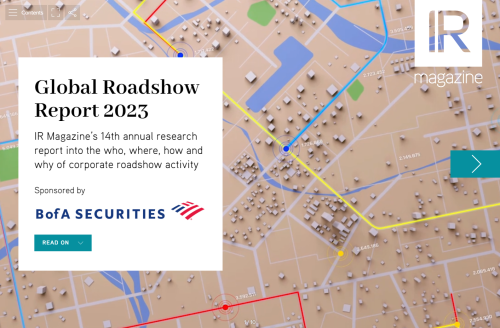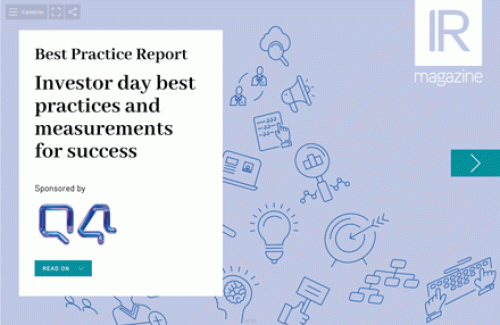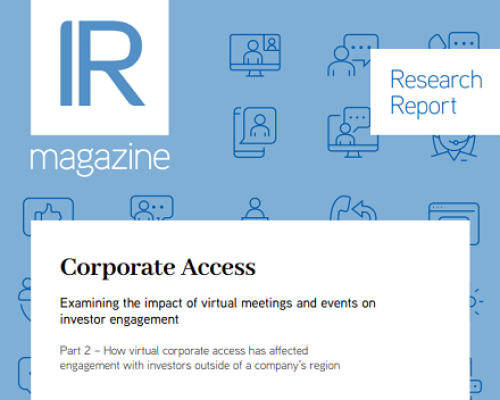|
|
At this point in 2020, even the most luddite among us has more or less mastered the Zoom meeting. But what’s it like to take a conference that hundreds of investors keep a placeholder for each year and turn it fully virtual? Luke Ahern, equity sales at Investec, helped do just that for the Best Ideas Conference in November. Here he shares some lessons learned with IR Magazine.
Not doing the conference really wasn’t an option, Ahern explains. The three-day Best Ideas Conference is one of the biggest in Investec’s calendar and has a spot just before Thanksgiving – something the firm didn’t want to lose, especially as investors keep a placeholder for it a year in advance.
‘We decided we couldn’t be half-pregnant with regards to the conference,’ says Ahern. ‘If we were going to do it as a 100 percent virtual conference then we had to do it properly – and a lot of work went into it.’
In terms of numbers, the virtual event was comparable with previous, in-person years: 76 companies presented to 300 investors, with corporates typically seeing 30-40 investors a day, and eight meeting slots per day, he explains. Over the three days, the event created around 2,500 one-hour slots of investor time with UK and Ireland mid to large-cap management teams.
‘Our list of companies was the crème de la crème of UK PLCs,’ Ahern says. ‘International investors are under-invested in the UK at the moment and, if they do come in, they’re going to buy very high-quality businesses. UK to UK is always going to be there but we saw a definite shift toward more European investors and more from the US this year – particularly as we head toward Brexit.’
But while 2019 saw investors fly in from Japan, India and Australia for the virtual event, the time difference meant investors from eastern time zones were largely absent, he adds.
Wrap it up
Investec had concerns about organizing such a large event completely online. ‘We were very wary of this turning into something of a talk-radio show, where you could click in for a stream of company presentations,’ Ahern notes.
‘We were keen for it to be something where there was two-way engagement because if you are asking the management team of JD Sports or JD Weatherspoon – both of which presented – to talk to investors, then those companies want feedback, too.’
Part of Investec’s solution was to provide a ‘chaperone’ in each meeting.
‘Rather than sending a company in on its own and saying, Give me a call in a couple of hours and tell me how it went, we decided to have someone there 10 minutes before the call started, then getting the Q&A moving and also wrapping the meeting up after 45 minutes,’ Ahern says, adding that Investec was initially unsure of whether or not to do this but that in the end it provided real support.
‘You can’t just have a pipe where you say here’s a company and here are some investors: now get on with it,’ he says. ‘So we were there as a friend and business associate and we were able to humanize things a bit more. We helped move questions along and made sure the time was used wisely.’
Ahern and the team made sure company management had a bit of a break between meetings. And if there’s one tip IROs take away from the conference, it’s the importance of having someone there to say: right, let’s wrap this up – something that can be trickier than usual in a virtual meeting. ‘Managers can then go stretch their legs, walk around the house and grab a coffee,’ says Ahern. ‘That really makes people fresher.’
He says other lessons were learned, too, and that with hindsight, perhaps eight meetings per day for three days is not necessarily the right number. But it’s not just about the number of meetings; it’s also about when they take place.
‘Why not two in the morning, starting a bit later and then catch more of the US market later in the afternoon?’ Ahern suggests. ‘You also need to think about which are the busy times of day in the stock market you’re talking to and consider whether you’re likely to lose people.’
There was also more movement within the schedule, he adds: ‘There will always be mobility [but] when it’s not face to face, I think there is a bit more of that than usual. Corporates should be mindful of the fact that attendees are going to be a bit more fluid.’
The future is mixed
For Investec – and for companies and investors around the world – Ahern says you really have to learn as much as possible from this year. Like many, he sees a mixed model emerging for corporate access in the future: ‘You’ll have people in the audience for face-to-face meetings, with others watching virtually.’ But for the virtual side, he says ‘you’ve got to have a good tech platform, you need to really think ahead and also be ready to be versatile and nimble.’
There are clear benefits to virtual meetings and conferences aside from the fact they can continue to take place in a Covid-19-stricken world. In addition to the fact that you can see anyone, anywhere in the world with efficiency, Ahern also mentions the environmental side.
‘It almost brings you to tears seeing the number of presentations thrown away, even if they’re recycled, after a conference,’ he says. ‘But there’s also a part of me that knows that if investors really wants to see a company – or vice versa – they will travel to do that because they do want to see the whites of people’s eyes.’











